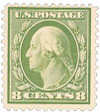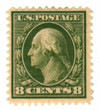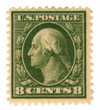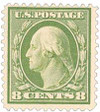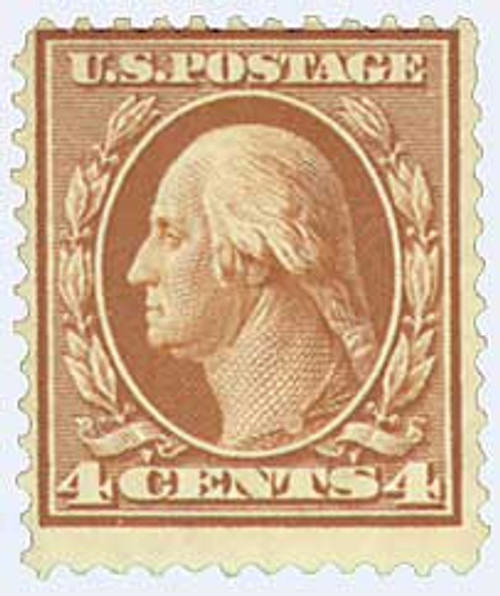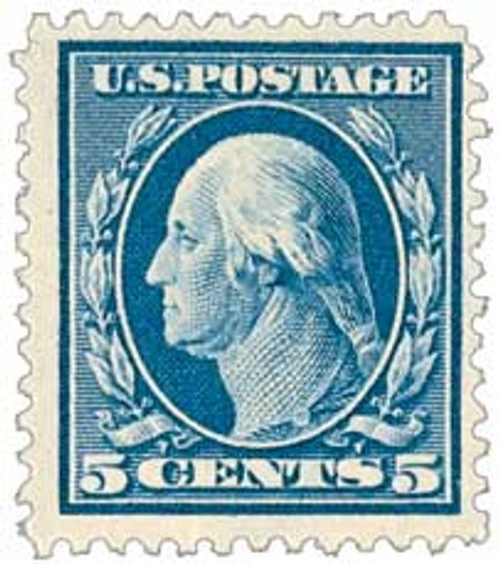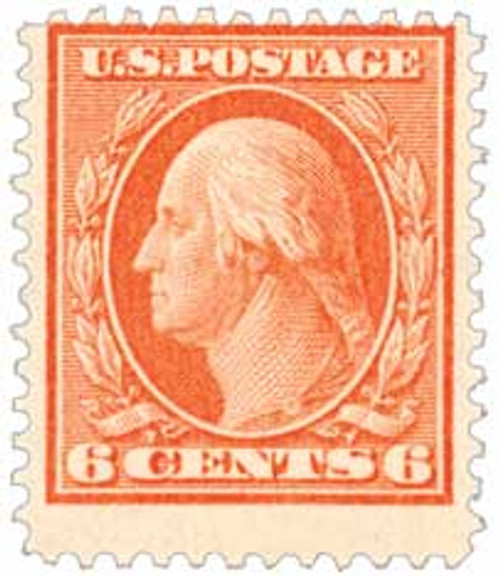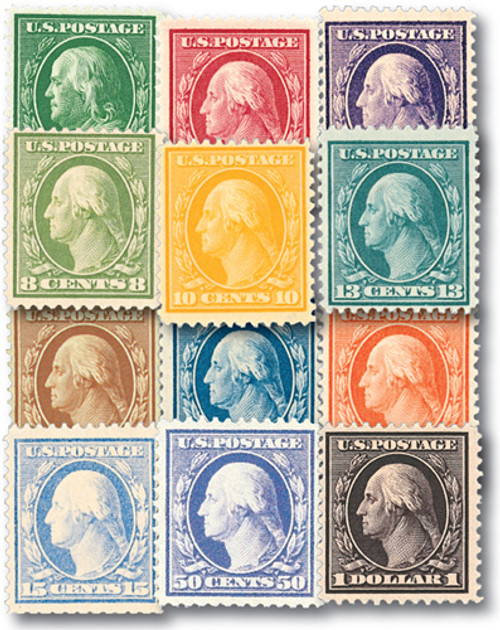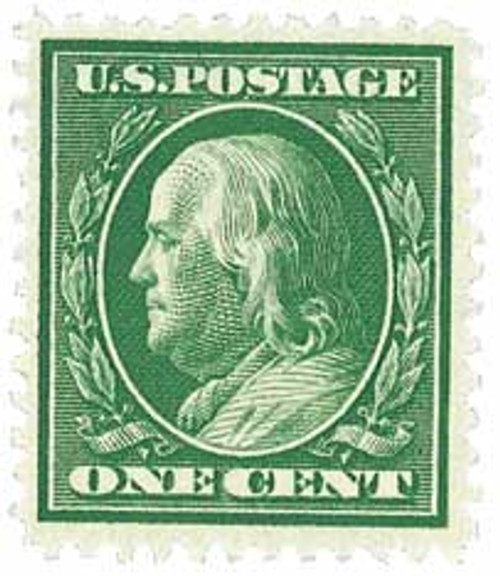
1908 8c Washington, olive green, double line watermark
# 337 - 1908 8c Washington, olive green, double line watermark
$3.00 - $610.00
U.S. #337
Series of 1908-09 8¢ Washington
Series of 1908-09 8¢ Washington
Issue Date: December 12, 1908
Quantity issued: 94,000,000
Printed by: Bureau of Engraving and Printing
Method: Flat plate
Watermark: Double line
Perforation: 12
Color: Olive green
Quantity issued: 94,000,000
Printed by: Bureau of Engraving and Printing
Method: Flat plate
Watermark: Double line
Perforation: 12
Color: Olive green
The Series of 1908-09 8¢ Washington stamp was issued primarily to pay the registration fee and also for letters weighing more than three ounces.
Unlike lower values that were also printed with star plates, the 8¢ denomination was only printed from standard spaced plates. (Star plates were being prepared, but they weren’t used until the single line watermark paper was introduced in 1910.)
Series of 1908-09
When the 1902 series was issued, the Post Office Department received numerous complaints from collectors, as well as the public, concerning the stamps’ poor designs. One particular gentleman, Charles Dalton, even wrote to his senator! He severely criticized the Stuart portrait of Washington currently in use on the 2¢ stamp and suggested the profile, taken from the bust by Jean Antoine Houdon, be put back into use.
He also recommended that this portrait be used on all U.S. issues. To support his idea, he used the example of Great Britain’s stamps, which all carried the profile portrait of King Edward VII. After careful consideration, the Postmaster General and Department officials adopted Mr. Dalton’s suggestions for the new 1908 series. The decision was made to keep Benjamin Franklin on the 1¢ stamp; however, his portrait was also to be in profile, modeled after Houdon’s bust.
A simpler and more modern-looking border design was selected to be used on all denominations. The simplicity and uniformity of the new design greatly reduced production costs and extended the life of the steel printing plates. Due to lower international rates and higher weight limits per unit, the need for the $2 and $5 stamps diminished. When the 1908 was released, these issues were discontinued.
Issued during the American Industrial Revolution, the series of 1908 was released in an age when machines were being developed to do anything man could and more. These inventions ranged from automated manufacturing plants and flying machines to the horseless carriage and slot machines. These slot or vending machines first appeared in the late 1880s to sell chewing gum on New York City train platforms. By the twentieth century, they also dispensed products such as candy, cigarettes, and souvenir postcards.
These vending machines were so successful that the companies that manufactured them were constantly seeking new items to market. Their attention was soon turned to postage stamps. Not only would this venture prove profitable for the manufacturers, it could also save a sizable amount of money of the government.
On November 24, 1905, a committee was appointed to investigate the possibility of using vending machines to see stamps. The committee was to determine whether or not this would be a worthwhile endeavor for the Postal Department to undertake. After examining the merits of these machines they reported, “...that the adoption of automatic machines for the sale of stamped paper would not, for the present, be advantageous.” The idea was abandoned until 1907.
U.S. #337
Series of 1908-09 8¢ Washington
Series of 1908-09 8¢ Washington
Issue Date: December 12, 1908
Quantity issued: 94,000,000
Printed by: Bureau of Engraving and Printing
Method: Flat plate
Watermark: Double line
Perforation: 12
Color: Olive green
Quantity issued: 94,000,000
Printed by: Bureau of Engraving and Printing
Method: Flat plate
Watermark: Double line
Perforation: 12
Color: Olive green
The Series of 1908-09 8¢ Washington stamp was issued primarily to pay the registration fee and also for letters weighing more than three ounces.
Unlike lower values that were also printed with star plates, the 8¢ denomination was only printed from standard spaced plates. (Star plates were being prepared, but they weren’t used until the single line watermark paper was introduced in 1910.)
Series of 1908-09
When the 1902 series was issued, the Post Office Department received numerous complaints from collectors, as well as the public, concerning the stamps’ poor designs. One particular gentleman, Charles Dalton, even wrote to his senator! He severely criticized the Stuart portrait of Washington currently in use on the 2¢ stamp and suggested the profile, taken from the bust by Jean Antoine Houdon, be put back into use.
He also recommended that this portrait be used on all U.S. issues. To support his idea, he used the example of Great Britain’s stamps, which all carried the profile portrait of King Edward VII. After careful consideration, the Postmaster General and Department officials adopted Mr. Dalton’s suggestions for the new 1908 series. The decision was made to keep Benjamin Franklin on the 1¢ stamp; however, his portrait was also to be in profile, modeled after Houdon’s bust.
A simpler and more modern-looking border design was selected to be used on all denominations. The simplicity and uniformity of the new design greatly reduced production costs and extended the life of the steel printing plates. Due to lower international rates and higher weight limits per unit, the need for the $2 and $5 stamps diminished. When the 1908 was released, these issues were discontinued.
Issued during the American Industrial Revolution, the series of 1908 was released in an age when machines were being developed to do anything man could and more. These inventions ranged from automated manufacturing plants and flying machines to the horseless carriage and slot machines. These slot or vending machines first appeared in the late 1880s to sell chewing gum on New York City train platforms. By the twentieth century, they also dispensed products such as candy, cigarettes, and souvenir postcards.
These vending machines were so successful that the companies that manufactured them were constantly seeking new items to market. Their attention was soon turned to postage stamps. Not only would this venture prove profitable for the manufacturers, it could also save a sizable amount of money of the government.
On November 24, 1905, a committee was appointed to investigate the possibility of using vending machines to see stamps. The committee was to determine whether or not this would be a worthwhile endeavor for the Postal Department to undertake. After examining the merits of these machines they reported, “...that the adoption of automatic machines for the sale of stamped paper would not, for the present, be advantageous.” The idea was abandoned until 1907.



